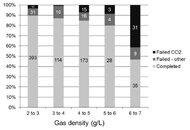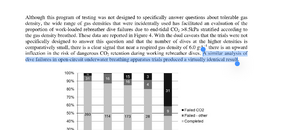I think that threshold is 6.2 g/L. 5.2g/L is considered very good.If your CCR is functioning properly, there should also be negligible CO2, but that's not the issue. Nor is it the OC inhalation effort (regs have venturi assist, "over balanced" designs, etc.). The issue is the additional effort to move the denser gas out of the lungs has a tendency to shortchange the expired volume. (IIRC, the vital capacity was cut by ~50% in tests at the 5.2 g/L density level.) That leads to more CO2 remaining in the lungs and the associated problems thereof.
You are using an out of date browser. It may not display this or other websites correctly.
You should upgrade or use an alternative browser.
You should upgrade or use an alternative browser.
Deco dive with divers on different back gas
- Thread starter sunny_diver
- Start date
Please register or login
Welcome to ScubaBoard, the world's largest scuba diving community. Registration is not required to read the forums, but we encourage you to join. Joining has its benefits and enables you to participate in the discussions.
Benefits of registering include
- Ability to post and comment on topics and discussions.
- A Free photo gallery to share your dive photos with the world.
- You can make this box go away
Did you read it?Digging into that link...
The linked paper is: Rebreathers and Scientific Diving - Workshop Proceedings
Is carbon dioxide retention as big an issue in open circuit diving compared with rebreather diving? One of the features of open circuit is each breath is from a clean source of "unbreathed" gas, so no CO2. Also OC generally has a very low work of breathing (assuming the second stage regulator is correctly used -- lever in breathe mode, cracking resistance correct, serviced, etc.).
Am not disrespecting the research at all, am just bringing it to the current topic of lightweight decompression on open circuit in the 45m/150ft range. For all of us diving beyond this level, often well beyond, then we'd be taking into account the gas densities and, as we're using rebreathers, high helium percentages are preferable.
BTW: great link, interesting paper.
Attachments
Yes, but that bar graph is different from vital capacity. The 5.2 g/L is the recommended limit. (Yes, it's a little weird they make 2 recommendations for limits.)I think that threshold is 6.2 g/L. 5.2g/L is considered very good.
Apparently, my memory is doing OK. From this DAN writeup:
One study indicated that at a depth of 100 feet, the maximum volume of gas that you can inhale and exhale in one minute (maximum voluntary ventilation) is approximately half of what it would be at the surface.
(Density of air at 100 ft is 5.2 g/L.)I can understand that 50% ventilation penalty causing the performance degradation depicted in that bar graph. I don't know the vital capacity reduction at 6 g/L, but the more severe failure rate in the bar chart would suggest a nonlinear impact.
Blackcrusader
Contributor
I think the ccr discourse has ventured off too far from what the op asked. What he asked is not unsafe if planned for
Boarderguy
Chief Narctopus Wrangler
Just did a 100fsw dive today. Buddy had 32 and I was on air. Same ocean, same dive plan, different gasses. My deco obligation was 26 minutes after faffing around trying to find my lost go pro. We didn't die and nobody impounded our equipment.
Blackcrusader
Contributor
It's a miracleJust did a 100fsw dive today. Buddy had 32 and I was on air. Same ocean, same dive plan, different gasses. My deco obligation was 26 minutes after faffing around trying to find my lost go pro. We didn't die and nobody impounded our equipment.
I would emphasize the importance of communication during the dive. There is always slight variation even if divers use the same gas and same GF, and having different gases mean higher variation. Communicate a plan ahead of the dive that fulfill the conditions of both divers, and continuously update each other during the dive.
Earlier in this thread there was this notion that if the EAN32 diver set their computer to air, then they could see the expected deco schedule of the air diver. This seems like a dangerous assumption.
Earlier in this thread there was this notion that if the EAN32 diver set their computer to air, then they could see the expected deco schedule of the air diver. This seems like a dangerous assumption.
larsdennert
Contributor
I've actually been in an emergency scenario like this, diving a resort group trip. Most of us were diving 32 but a few were diving 21. At about 80ft cruising along I paused taking photos and looked down to see another diver at about 100ft shooting video. He was on air and not my dive buddy. Looking at my pressure and knowing his sac in general was much higher than me along with being deeper, I estimated he must be really low on air. I got his attention and asked about air. His eyes got really wide.
500psi wasn't going to do it for him. I took him by the bc and offered a reg as we ascended for a stop and he declined. Here's the interesting thing. At the time I was diving a computer where it doesn't remember the gas and has to be set almost every dive. It had reset to 21% so I happened to have a good estimation of his deco obligation. Between my computer and fudging the 120 rule I could let him watch his computer to make sure he did his full stop. He ran out of air on the deco stop and finally took up my offer instead of bolting for the surface. All good and he learned some useful things.
500psi wasn't going to do it for him. I took him by the bc and offered a reg as we ascended for a stop and he declined. Here's the interesting thing. At the time I was diving a computer where it doesn't remember the gas and has to be set almost every dive. It had reset to 21% so I happened to have a good estimation of his deco obligation. Between my computer and fudging the 120 rule I could let him watch his computer to make sure he did his full stop. He ran out of air on the deco stop and finally took up my offer instead of bolting for the surface. All good and he learned some useful things.
Normygenius
Registered
not so cut n dry though!The downsides seems pretty cut & dry by "DIR" or really any other diving standards/theory:
1) Diver B is stuck doing 8 extra minutes of deco because his teammate showed up with the wrong gas for the dive plan
2) Diver A is taking on additional nitrogen exposure for absolutely no reason or benefit because he showed up for the wrong gas for the dive. If he was able to get his deco bottle filled up with 50%, he could have gotten his back gas filled with 32% which would be far more appropriate for a 100' dive than 21%.
3) Trusting anything your computer tells you when you have it set to the wrong gas mix is never a good idea for any reason or any scenario, that should be self-evident.
1) Using air to 100' is not inherently "wrong". The context is whether there was a prior specific agreement to both use 32% 2) You assume that Diver A's back cylinder is eanx rated like his deco tank? 3) when diving nitrox with an air Diver, no need to reset your computer, rather just follow the air divers time limits but be super clear about your MOD!
old frogman
Contributor
As usual, the do it ridiculous have jumped in and gone off on a tangent.Diver A has air. Diver B has EAN32. Both have 50% for deco.
The dive is 100 ft for 30 minutes. Let's say using air would require 16 minutes of deco and EAN32 requires 8 minutes.
The EAN32 diver agrees to put their computer in air mode or use air tables. Both divers follow the same deco schedule and do 16 minutes of deco.
If a gas share is required, they still assume the back gas is air.
Any downsides?
You have two options as follows:
1. Both stick together and do the 16 mins deco.
2. One diver does the 8 mins and gets out of water and the other completes the last 8 mins solo.
Both will work. and have been done before by a multitude of divers except for the GUE guys who essentially, despite all the noise in this website, constitute a far left minority. Probably .000000000
It all boils down the situational conditions in the water, your capability for solo diving and how much risk you are willing to tolerate.
Similar threads
- Replies
- 30
- Views
- 1,941
- Replies
- 11
- Views
- 858
- Replies
- 71
- Views
- 7,139






